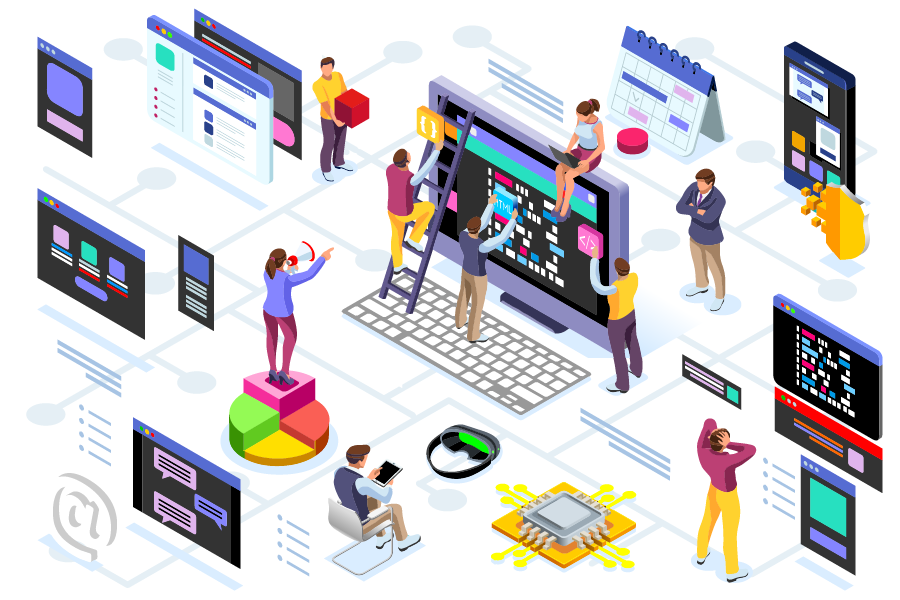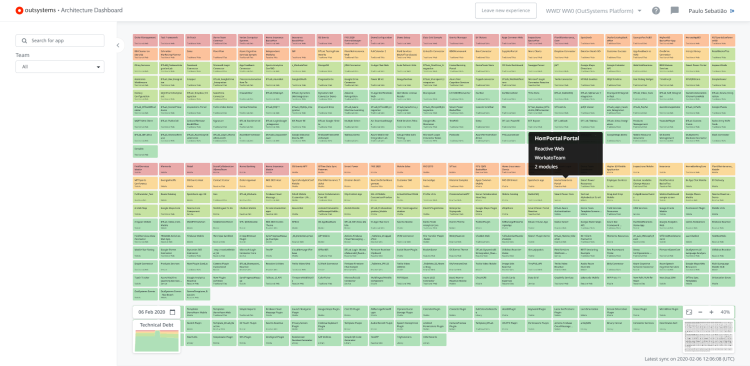Why Low-Code Projects Will Benefit from a ‘Decoupled’ App Platform Architecture
Interest in low-code / no code platforms is skyrocketing in 2021, as companies strain to reduce their growing backlog of app requests. IDN speaks with OutSystems CEO Paulo Rosado about how using a low-code platform with a 'decoupled' architecture will improve productivity, flexibility and scale.
by Vance McCarthy
Tags: apps, architecture, integration, no code, low-code, OutSystems, scale, services,

CEO

"A decoupled architecture lets businesses amass pieces or parts into a portfolio which can evolve at multiple speeds and work together."
 Modern Application Development for Digital Business Success
Modern Application Development for Digital Business SuccessAs enterprises strain to keep up with growing backlogs, low-code/no-code platforms are grabbing lots of attention in 2021.
The technology promises to reduce the time it takes to develop apps. Even better, by abstracting many complexities, many low-code/no code platforms let non-technical workers build effective apps, which expands a company's pool of capable app builders.
When a company can build apps faster -- and have more app builders on staff – backlogs begin to disappear.
OutSystems' low-code/no code platform delivers these benefits. Plus, thanks to its 'decoupled architecture' architecture, OutSystems goes further to deliver an even more valuable set of 'big picture" benefits, CEO Paulo Rosado told IDN.
The OutSystems platform enables organizations of all sizes to build the software that makes the difference - whether it's for transforming customer experiences, delivering workplace innovation, automating processes, or modernizing core systems. OutSystems makes this possible by combining extraordinarily fast, visual, model-driven development with a modern platform built around AI, cloud, DevOps, and security.
"A lot of people are jumping into what's now called no-code/low-code just to ride the wave of interest in a lot of ways. At OutSystems, we keep on focusing on solving the problem we set ourselves to solve when we started the company. And that is: How can we make the craft of software development in the enterprise and the enterprise context extremely simple and much faster.
In an "enterprise context," Rosado said, low-code / no-code apps built with OutSystems are automatically highly scalable, highly secure, highly maintainable.
"We make sure that whatever you build, you're not going to hit the wall like you did with a lot of the predecessors of these platforms," he added.
Another aspect of 'enterprise context' OutSystems focuses on is the power to treat all low-code/no-code work product as a fungible suite of portfolio assets. This is the big picture for low-code," Rosado said.
When companies first explore low-code, "everyone is looking into building one app or one workflow and then build another one," he added. "That misses the big value opportunity with low-code."

If companies look at only 1 or 2 apps they want to build, users can end up with low-code apps stuck running in silos. This means new low-code apps are unaware of a businesses' existing (and yet-to-be-built) high-value assets, such as data, logic, or services already used by other apps and software services.
To avoid this 'siloed app' outcome when using low-code/no-code, Rosado suggests companies should look for a low-code "architecture' – not merely a low-code platform.
"[Think about] what it can mean to have an architecture, where you fundamentally have your business running on top of digital platforms. Rather than using a traditional platform and having a large number of siloed, a decoupled architecture lets businesses amass pieces or parts into a portfolio, which can evolve at multiple speeds and work together," he said.
Another element OutSystems focuses on is control.
"What I think is cool is that the OutSystems platform gives you a tremendous amount of power and governance, but it doesn't compromise that with flexibility," Rosado told IDN. "So that speed and agility that companies usually look for with low-code come at the price, which is you're not going to have control and governance and the big picture portfolio view of all your low-code apps."
In Rosado's opinion, companies should take a longer view when considering a low-code/no-code platform. Low-code is not just about how businesses can build apps faster, he said. It should also be about "how will they get control over all those resources, and get them working together – and doing all of that fast and easily."
He added some perspective on why the long view is an essential question.
A company may have an urgent need to get 1 or 2 key apps built initially, but pretty quickly, that company will many, many low-code / no-code apps and services, he said. "In the end, you may be looking at a 1000 applications or more. Without a flexible architecture to support their full lifecycle, you may need to re-platform," Rosado said.
3 Strict Tenants of OutSystem’s ‘Decoupled’ Low-Code Architecture
OutSystems based its low-code / no-code architecture on what Paolo calls "three strict tenants."
"First, there is Built Fast, which is speed.
"Another is Build Right, which is, when you go very fast, sometimes you tend to forget that things need to scale and needs to be highly secure.
"And then actually the most important probably is Built for the Future, because if you're building something and you lose all your developers, which is a very common scenario today, you're going to have a bunch of orphan code. Then, you have to write the whole thing again.
And so, we look into the whole anatomy of producing software and maintaining it and the full lifecycle," Rosado said. "We're always asking: 'How can we help customers, who do not have huge [IT or developer] capacity that the elite companies do, reach their goals?
OutSystems' decoupled architecture' low-code platform takes the view that low-code apps and services should be 'Lego Blocks" that companies can easily customize to suit their needs.
This approach to low-code creates opportunity for companies because it lets them leverage and rearranging all those Lego pieces -- and add in what Rosado calls "your secret sauce on top" to build flexible and innovative apps and services. Once built, these new assets can work with a company's existing software and cloud-based SaaS services – and all without the need for tons of custom hand-coding.
Rosado puts it this way:
"So whenever you have an extra idea, you can do it very, very quickly on your own - in as little as days. This lets you control your roadmap, instead of waiting for the cycles of the SaaS vendor, which is probably only going to add that feature you want only when he has 1000 requests from 1000 customers."
Taken in this 'enterprise context,' the benefits to low-code will truly multiply, he added.
"As you grow and build more and more of these [low code] assets and apps, more and more of your' secret sauce' becomes built into the fabric of your organization." And then, you can easily integrate, share, reuse and scale them throughout the portfolio – with visibility and reliability, he added.
So what exactly in the OutSystems' architecture lets companies take the long-view of low-code benefits?
Rosado explained the vision and methodology behind OutSystems' decoupled architecture' approach, vis-à-vis other low code platforms.
"If you get into a drill down into these types of platforms and you get to the second level down into the core features of these platforms, probably one of the most important aspects is whether you have an interpreter mentality or a compiler mentality?

Rosado explained the difference, and how one delivers more benefits – and few limitations:
A compiler mentality is when you use visual modeling or no codes concepts to express your program and what the system wants to do. You have technology in the middle, such as a code generator or a compiler technology. It delivers uncoupled work product, which produces workloads that are completely standard and can work independently of the modeling or the no-code portion of the system. The result: Low-code apps with maximum flexibility and easy to integrate with other assets, apps, or services.
An interpreter mentality uses a model where you shove it down to the runtime. This model is the thing that's going to run until you interpret that graph, model, or piece of no code. Simpler, but not uncoupled because that element is now part of the runtime. This approach lacks the deep uncoupling technique of a compiler approach, which means companies can run into complexities when they look to innovate, scale or integrate their low code apps together.
Rosado’s advice:
While the interpreter model is easier to implement within a low-code / no-code platform because it is not a decoupled architecture, it has dependencies, and so it also has limitations. Without a decoupled architecture, companies can run into "a lot of problems" with their low-code / no-code work product, he told IDN.
"With respect to mission criticality and high scalability, there are particular things you cannot do if you don't completely isolate the runtime from the code [generation] layer. For complete control and enterprise-class functionality, you have to separate both.
“So what we did at OutSystems is that we not only separated both, but we put in a lot of AI expertise and processes into the runtime and that generation [layer] so that we can solve a lot of issues.
Thanks to OutSystems' use of a compiler-model to create a decoupled architecture, companies have a wide range of flexibility and ease-of-use, while ensuring the company’s IT team retains control and governance. This is especially true when it comes to integrations, Rosado said.
"We are able to integrate with external pieces of inside enterprises and then underneath. We are also free to do integrations [outside the enterprise] through VPNs or cloud such as AWS, Google, or even new state of the art technologies" that haven't even been invented yet.
"One of the things that's really cool is, the moment you have that separation, and you have that compiler decoupling model, even if the user doesn't do anything, you can restructure the target runtime and the workloads of your application. This becomes hugely important when you realize by usage that what you thought was going to have 50 users using your product now has 50 million users.
“With OutSystems, you do not need to tell the system that [your app] needs to scale to 50 million – our system automatically adapts to that type of world and skills.”
This type of auto-scale and other 'enterprise context' capabilities for low code / no-code apps is why Rosado means when he talks about helping companies keep pace and compete with the largest, elite enterprises – even with drastically smaller resources.
“We believe it's absolutely crucial that we give IT departments the capacity to analyze their portfolios and to control the technical debt while at the same time have their teams move at very warp speed. So it's a unique combination of flexibility and agility with centralized governance and control,” he told IDN.
OutSystems offers dashboards, visibility and change management technologies, which combined allow a new developer or admin can maintain existing apps and have the time and bandwidth to build new ones.
"We see it all the time. Someone new comes in into a company and with OutSystems they can very quickly understand exactly what's there, make some changes, maintain the apps, easily scale it – and even add more innovation on top,” Rosado said. “It's made so simple that these staff can also move on to another project without being overwhelmed.”
And in order for you to deal with portfolios like this but still be fast and agile, which is the promise of these types of platforms, right? You have to have mechanisms that implement and give you the capacity to create that architecture. That portfolio management.
How A Low-Code ‘Decoupled’ Architecture Drives Differentiation
As we wrap up, Rosado shared one last reason why companies looking for low-code solutions should consider their 'big picture' Future.
After a decade or more of adopting SaaS (cloud-based software-as-a-service), the drive to differentiate is growing within companies. Yes, SaaS has been great for smaller firms looking to upgrade their internal and customer apps. But, increasingly, businesses are noticing that they are losing some degree of differentiation.
"When you needed to catch up quickly to competitors, SaaS let you do it very, very quickly. But we're now seeing businesses will start hitting a disconnect between what they want to do -- and the things that are readily available in these SaaS platforms." This disconnect creates a lot of what Rosado calls 'white spaces'" that need to be filled in.
Put another way: Any SaaS is never quite 100% right. People just want one or two more tweaks.
Rosado explains it this way:
"You start getting a lot of change requests coming from the business, saying there's a gap here and there. They'll say, "There's a gap in data. There's a gap in the process. There's a gap in UX.
"So, your developers started getting all these change requests. But, there's no place for those things to land in your current SaaS configuration. Worse, cloud services are particularly difficult to customize. It's actually impossible in many cases to customize them, right?"
This frustration gets even more painful, Rosado added, when you factor in the typical company that already uses 1000 SaaS or cloud services.
OutSystems decoupled architecture approach to low-code is resounding with many analysts and VCs. Earlier this year, the company announced a $150 million capital raise from Abdiel Capital and Tiger Global.
Related:
- InfluxData's Latest Updates Optimize Time Series Data for Better Performance, Scale and Management
- Actian Zen 16.0 Update Simplifies Delivery and Boosts Performance of Edge, IoT Apps
- Virtana Infrastructure Performance Management Adds AI-driven Capacity Planning
- e2open’s Supply Chain SaaS Updates Help Firms Reduce Operational Risks with Deeper Visibility
- Report: Endor Labs Identifies 2023 Operational, Security Risks To Open Source
All rights reserved © 2025 Enterprise Integration News, Inc.


